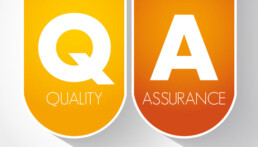10 Best Quality Assurance Practices in Innovation
Pushing the parameters of perfection, you’ll examine the 10 best quality assurance practices in innovation.
You’ll learn how to establish efficient and effective QA systems that will fuel your firm’s future growth.
You’ll gain insights on how to integrate customer needs, rigorous testing, employee development, and the latest tech trends into your QA process.
Additionally, you’ll explore strategies for continuous improvement, fostering a culture of innovation, leveraging predictive analytics, and setting up a robust feedback mechanism.
So, let’s get you geared up to guarantee quality and drive innovation in your business.
Key Takeaways
- QA is crucial for product success and acts as the backbone of innovation.
- Adopt a customer-centric approach in QA practices to optimize the user experience.
- Rigorous testing procedures ensure product functionality and reliability.
- Investing in team skill development and technology integration is essential for maintaining high-quality standards.

Understanding the Importance of QA
In the realm of innovation, it’s crucial for you to grasp the significance of Quality Assurance (QA) as it’s the backbone of product success.
QA Metrics Analysis helps you measure the effectiveness of your QA efforts, providing strategic insight into areas that need improvement. It’s a tool for continuous refinement, ensuring that your product meets the highest standards.
Additionally, Risk Management in QA plays an indispensable role. It’s about identifying potential issues that could jeopardize the quality of your product and devising strategies to mitigate those risks.
Embracing a Customer-Centric Approach
To truly excel at innovation, you must adopt a customer-centric approach in your QA practices, placing your customer’s needs at the heart of your product development process. This requires personalizing the user experience to reflect their precise needs and expectations.
By aligning your QA practices with your customer’s perspective, you’ll optimize their journey from initial engagement to long-term loyalty. You can’t ignore the importance of this approach. It’s more than just a strategy; it’s an essential part of ensuring your product’s viability in a competitive market.
So, dive deep into your customers’ needs, expectations, and feedback. Use this crucial information to shape your product, streamline your processes, and strengthen your QA practices.
Implementing Rigorous Testing Procedures
You’ll need to implement rigorous testing procedures as part of your quality assurance strategy to ensure your product’s functionality and reliability. This is where Automation Advantages come into play. By automating tests, you can increase efficiency, reduce errors, and save time. Automation enables repeatable testing, which is critical for catching defects early and often.
Moreover, consider the benefits of Offshore Testing. It allows your team to focus on core tasks while an external team handles the testing process. This approach can enhance your product’s quality by providing a fresh perspective and mitigating biases that may exist within your internal team.
Strategic implementation of rigorous testing procedures, leveraging automation and offshore testing, can significantly improve your product’s reliability and overall performance.
Encouraging Employee Training and Development
Investing in your team’s skill development is a crucial step toward maintaining high-quality standards in your innovation processes. By encouraging training and development, you’re not only augmenting their skills but also fostering a culture of continuous improvement.
Training incentives are an efficient way to motivate your team. They’re not just about monetary rewards, but also about recognizing and appreciating their efforts. Consider implementing a system where employees are acknowledged for their learning and development.
Skill augmentation is equally important. Regular training sessions, workshops, and seminars can help your team acquire new skills and enhance existing ones.
Below is a strategic approach to employee training:
| Training Incentives | Skill Augmentation |
|———————|——————–|
| Recognition | Regular Training |
| Rewards | Workshops |
| Time-off | Seminars |
| Career Progression | Online Courses |
| Peer Recognition | Mentoring |
With this approach, you’ll be ensuring quality standards while promoting innovation.
Leveraging Cutting-Edge Technology
In your quest for innovation, it’s essential that you leverage cutting-edge technology to streamline your quality assurance processes. Technology integration isn’t just a buzzword, it’s a strategic approach that can help you harness the power of the latest tools and techniques. By integrating advanced technology into your operations, you’ll be able to detect and rectify issues faster, thus ensuring the production of high-quality products.
Moreover, consider adopting Agile methodologies. Agile isn’t merely a project management approach; it’s a mindset that promotes flexibility, continuous improvement, and collaborative problem-solving. It’s a crucial tool for innovation, enabling you to adapt swiftly to changes and incorporate user feedback efficiently.
Ensuring Compliance With Industry Standards
To keep up with the ever-evolving business landscape, it’s crucial that you stay on top of industry standards and ensure your processes strictly adhere to these regulations. Regulatory adaptation is a key component of this, requiring you to be proactive and responsive to any changes within your industry.
You need to develop reliable compliance metrics to measure your adherence to these standards. These metrics provide valuable insights into where your practices stand in terms of compliance, helping you identify any gaps or areas of improvement. By making strategic adjustments based on these metrics, you can ensure your operations remain in line with industry standards.
Incorporating Continuous Improvement Strategies
How can you make your quality assurance practices even better? By incorporating continuous improvement strategies. Adaptive processes, central to this approach, allow for ongoing refinements to improve efficiency and reduce errors. They’re dynamic, not static, evolving with changes in technology and market demands.
The Kaizen philosophy, a Japanese concept of ‘continuous improvement’, can also be a game-changer. It emphasizes small, consistent changes that lead to major improvements over time. It’s about fostering a culture where every team member is actively involved in improving processes and products.
Remember, improvement isn’t a one-and-done deal. It’s a continuous journey. You’ll need to regularly reassess your strategies, adapt to new circumstances, and always aim for better.
The rewards? Enhanced quality, innovation, and business success.
Promoting a Culture of Innovation
Building on the concept of continuous improvement, you’ll find that promoting a culture of innovation is another key strategy for enhancing your quality assurance practices. Here’s how you can create such a culture:
- Innovation incentives: Reward creative thinking and successful implementations. This encourages employees to think outside the box.
- Risk-taking environment: A culture that accepts and learns from failures fosters innovation. It’s in these conditions that groundbreaking ideas are born.
- Open communication: Encourage collaboration and the exchange of ideas. This can lead to innovative solutions you mightn’t have considered.
- Continuous learning: Invest in training and development. It ensures your team is up-to-date with the latest industry trends, making innovation a constant.
Utilizing Predictive Analytics for QA
Moving forward with innovative quality assurance practices, you’re likely to find predictive analytics indispensable in your toolkit. Predictive analytics implementation in QA is about leveraging data to forecast potential issues, thus enabling preemptive action.
This strategic approach not only helps in identifying problems before they surface but also in understanding patterns that could give rise to them. You’re effectively turning data into actionable insights, driving decisions that enhance product quality and customer satisfaction.
In an era where data is abundant, your ability to harness it through predictive analytics can be a game-changer. It’s about making analytics-driven decisions that keep you ahead of the curve, ensuring that your QA practices aren’t just reactive, but proactive and foresighted.
This strategic foresight is what sets top-tier companies apart.
Establishing a Robust Feedback Mechanism
In addition to harnessing predictive analytics, you’ll find great value in establishing a robust feedback mechanism for your quality assurance process. The importance of communication can’t be stressed enough in this aspect.
Here’s a strategic approach you can follow:
- Identify suitable feedback channels: Surveys, interviews, or user testing can provide insightful data.
- Foster an open communication culture: Encourage your team to share their thoughts and observations.
- Analyze feedback data meticulously: Dig deep into the data, looking for trends and areas of improvement.
- Implement changes based on feedback: Take action, adjust your processes, and measure the impact.
In conclusion, you’ll find success in innovation by prioritizing quality assurance. Remember, it’s about placing your customer at the heart of your operations, implementing rigorous testing, promoting continuous learning, and leveraging the latest technology.
Embrace a culture of innovation, use predictive analytics, and establish a strong feedback mechanism. With these practices, you’ll not only improve your products and services but also foster a sustainable competitive edge.
